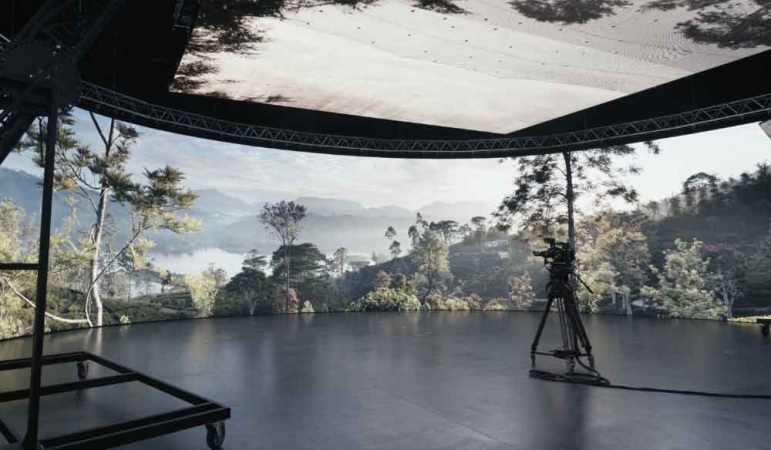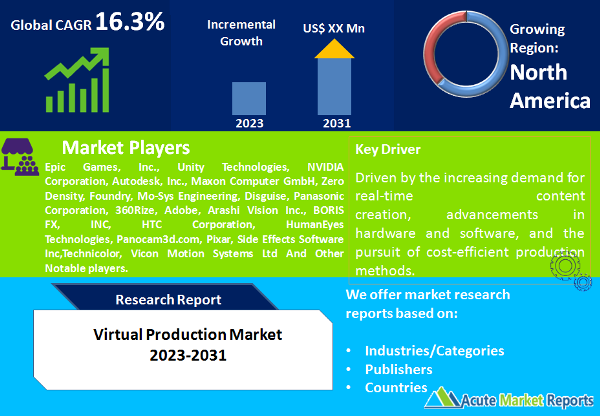
Virtual production has emerged as a transformative technology in the entertainment and film industry, enabling real-time integration of computer-generated imagery (CGI) and physical environments. This market has witnessed remarkable growth, driven by several key drivers. The virtual production market is expected to grow at a CAGR of 16.3% during the forecast period of 2025 to 2033, driven by the increasing demand for real-time content creation, advancements in hardware and software, and the pursuit of cost-efficient production methods. While content integration challenges remain a restraint, ongoing efforts in research and development are expected to address these issues. As the market continues to evolve, strategic partnerships, a focus on R&D, global expansion, diversification of offerings, and acquisitions will be pivotal in staying competitive. The forecasted shift toward hardware dominance and a surge in production-type virtual production further highlights the industry's potential. Overall, the virtual production market is on a trajectory of significant expansion, offering new opportunities for content creators, technology providers, and investors worldwide.

Rise in Demand for Real-time Content Creation
In recent years, there has been a surge in the demand for real-time content creation in the entertainment and gaming industries. Virtual production techniques allow filmmakers and content creators to visualize and manipulate digital assets in real-time. Evidence of this can be seen in the success of movies like "The Mandalorian," which extensively used virtual production, reducing post-production time and costs. The ability to create content in real-time not only accelerates the production process but also enhances creativity by enabling immediate visualization of scenes and effects. This driver is expected to continue stimulating the adoption of virtual production technologies throughout the forecast period.
Advancements in Hardware and Software
Technological advancements in hardware components such as high-resolution LED walls, camera tracking systems, and virtual reality headsets have significantly improved the capabilities of virtual production setups. The Unreal Engine, for instance, has become a popular software choice for real-time rendering and visual effects. These advancements have made virtual production more accessible and cost-effective for content creators. The high-quality visuals and immersive experiences achieved with these technologies have attracted major studios and production houses. Consequently, the market for both hardware and software components is set to expand further.
Cost Efficiency and Time Savings
Virtual production reduces the need for extensive physical sets, location scouting, and post-production work. It allows filmmakers to visualize complex scenes and make real-time adjustments, thus saving both time and money. This can be seen in the increasing number of film and TV productions adopting virtual production techniques to streamline their workflows. As the entertainment industry seeks more cost-efficient ways to create high-quality content, virtual production has emerged as a game-changer. The ability to reduce expenses and production timelines while maintaining visual excellence makes it a compelling choice for content creators and studios alike.
Challenges in Content Integration
Despite its numerous advantages, virtual production faces challenges in seamlessly integrating real actors and physical environments with digital elements. Achieving a cohesive and realistic visual style can be demanding, as seen in certain films where the integration of CGI elements is not seamless. Content integration issues can lead to visual inconsistencies and disrupt the viewer's suspension of disbelief. Filmmakers and studios must invest in skilled professionals and technology solutions to overcome this restraint and ensure a smooth blend of virtual and physical elements.
Market by Component: Software Components Dominate the Market
In 2024, the virtual production market was predominantly led by software components, driven by the popularity of real-time rendering engines like Unreal Engine. However, during the forecast period from 2025 to 2033, the hardware segment is expected to exhibit both the highest revenue and the highest compound annual growth rate (CAGR). This shift is attributed to the increasing adoption of advanced hardware components, such as LED walls and camera tracking systems, to enhance the immersive virtual production experience.
Market by Type: Post-Production Segment Dominates the Market
In 2024, the post-production type segment accounted for the highest revenue within the virtual production market due to its role in enhancing visual effects and CGI integration. However, during the forecast period from 2025 to 2033, the production type segment is expected to demonstrate both the highest revenue and the highest CAGR. This shift is fueled by the demand for real-time content creation and the need for immediate visualization of scenes, driving the adoption of virtual production techniques during the production phase.
North America Remains the Global Leader
In 2024, North America held the highest revenue percentage in the virtual production market, driven by the presence of major film studios and production houses in Hollywood. However, Asia-Pacific is expected to exhibit the highest CAGR during the forecast period. This growth is attributed to the expanding entertainment industry in countries like India and China, coupled with increasing investments in virtual production technologies. The region is set to become a significant market for virtual production services and solutions.
Market Competition to Intensify during the Forecast Period
The virtual production market is witnessing intense competition, with several key players shaping the industry's landscape. The key players in the virtual production market include Epic Games, Inc., Unity Technologies, NVIDIA Corporation, Autodesk, Inc., Maxon Computer GmbH, Zero Density, Foundry, Mo-Sys Engineering, Disguise, Panasonic Corporation, 360Rize, Adobe, Arashi Vision Inc. (Insta 360), BORIS FX, INC, HTC Corporation (VivePort), HumanEyes Technologies, Panocam3d.com, Pixar (The Walt Disney Company), Side Effects Software Inc (SideFX),Technicolor, Vicon Motion Systems Ltd, and others. Leading companies in the virtual production market are actively engaging in strategic partnerships and collaborations to expand their capabilities and offerings. For instance, technology companies are partnering with film studios and production houses to jointly develop cutting-edge virtual production solutions. These partnerships aim to leverage the strengths of each entity, ultimately delivering more comprehensive and effective virtual production tools and services. In a rapidly evolving field like virtual production, continuous innovation is paramount. Key players are heavily investing in research and development to enhance their software and hardware solutions. They are developing new features, improving real-time rendering capabilities, and optimizing hardware components for seamless integration. Such efforts ensure that their products remain at the forefront of the market and meet the evolving needs of content creators.
Historical & Forecast Period
This study report represents analysis of each segment from 2023 to 2033 considering 2024 as the base year. Compounded Annual Growth Rate (CAGR) for each of the respective segments estimated for the forecast period of 2025 to 2033.
The current report comprises of quantitative market estimations for each micro market for every geographical region and qualitative market analysis such as micro and macro environment analysis, market trends, competitive intelligence, segment analysis, porters five force model, top winning strategies, top investment markets, emerging trends and technological analysis, case studies, strategic conclusions and recommendations and other key market insights.
Research Methodology
The complete research study was conducted in three phases, namely: secondary research, primary research, and expert panel review. key data point that enables the estimation of Virtual Production market are as follows:
Market forecast was performed through proprietary software that analyzes various qualitative and quantitative factors. Growth rate and CAGR were estimated through intensive secondary and primary research. Data triangulation across various data points provides accuracy across various analyzed market segments in the report. Application of both top down and bottom-up approach for validation of market estimation assures logical, methodical and mathematical consistency of the quantitative data.
| ATTRIBUTE | DETAILS |
|---|---|
| Research Period | 2023-2033 |
| Base Year | 2024 |
| Forecast Period | 2025-2033 |
| Historical Year | 2023 |
| Unit | USD Million |
| Segmentation | |
Component
| |
Type
| |
End-User
| |
|
Region Segment (2023-2033; US$ Million)
|
Key questions answered in this report